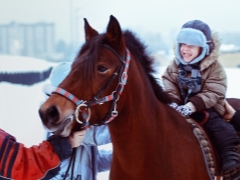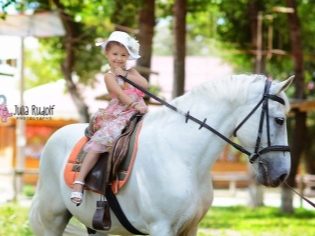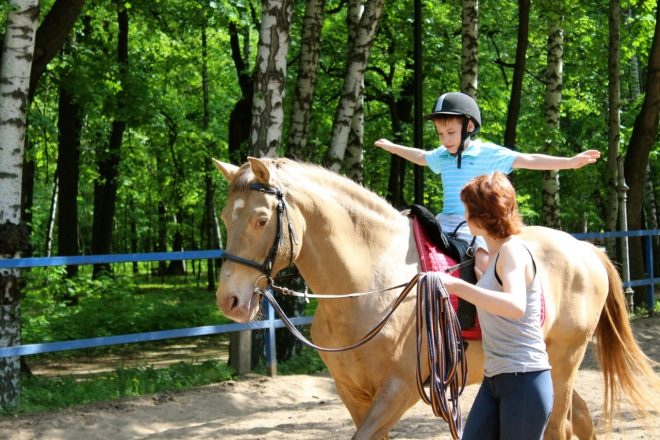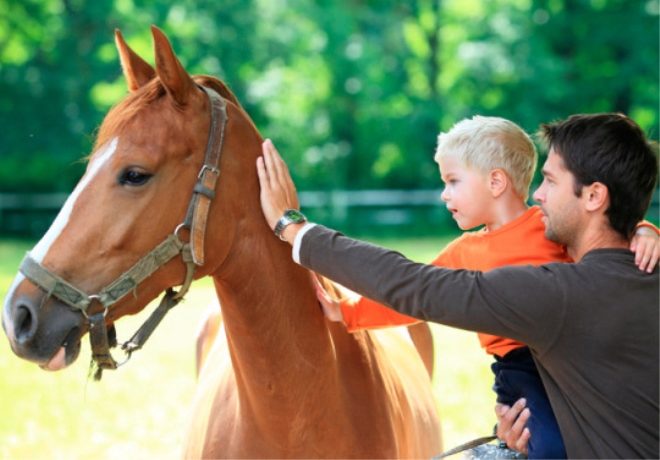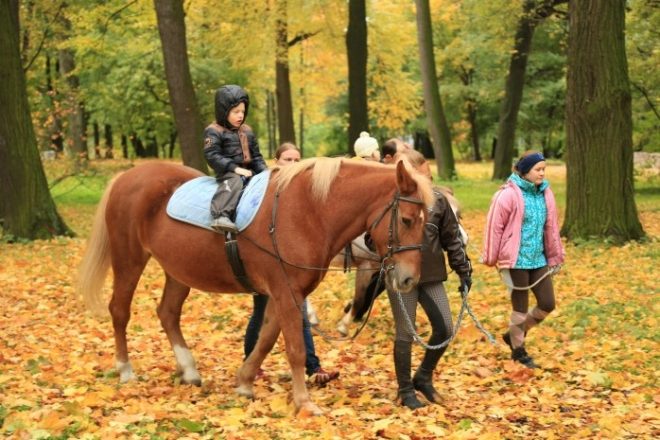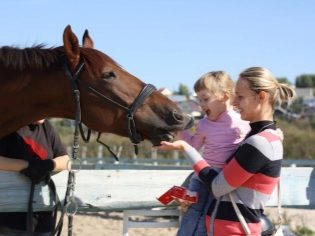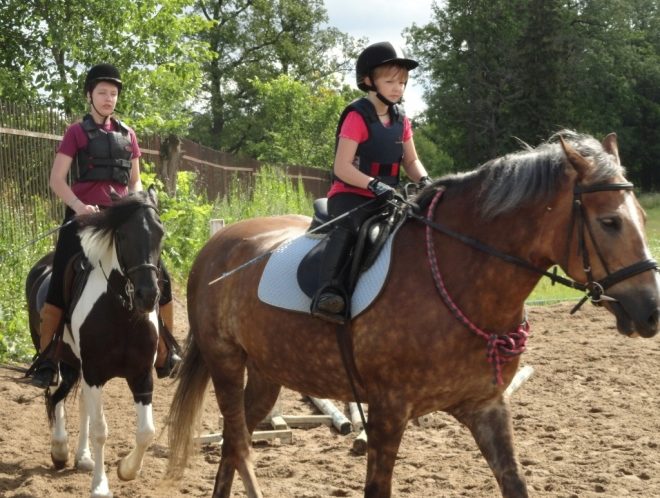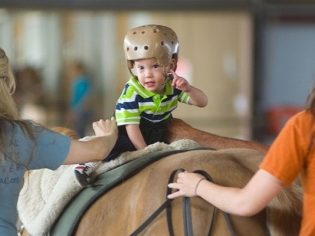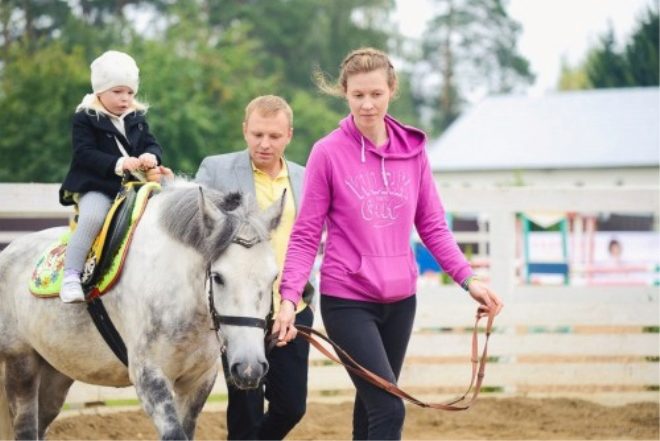What is hippotherapy and why is it useful for children?
Let's imagine a horse running across the field. What words can describe this picture? Freedom, confidence, grace, beauty, speed ... The list goes on.
This picture causes mostly positive emotions in the case when we are just observers. If there is an opportunity to touch nature with the help of horses, even more positive feelings arise!
Adults squeal with delight when they first get on a horse. And what about children and, especially, "special" children. What flurry of emotions does a little man have that is limited in physical abilities? He does not know how to walk, but he himself sits on a horse - from this he is overwhelmingly happy!
In ancient times, humanity was much closer to nature than it is now. It is known that even then animals resorted to treatment, and they healed! Many methods of animal medicine originated in the days of Hippocrates and have reached our days, but they are gaining popularity just now. Each has its own characteristics and strengths. Consider one of them, hippotherapy.
What is it?
Hippotherapy is one of the most effective methods of treating animals with horses. It is aimed at combating many diseases.
Some people call hippotherapy therapeutic horse riding. Yes, the main effect of the treatment is achieved precisely through the exercises performed on the horse. But still it is impossible to say that these two concepts are absolutely identical. After all, an important condition for healing is not only horse riding, but also simply communicating with the horse, caring for it.
The treatment uses an integrated approach: a person warms up and develops muscles, sitting on horseback, gets a crazy boost of energy and just a great pleasure from communicating with this animal.
Indications
Most often they fight with diseases such as cerebral palsy and various disorders of the musculoskeletal system, as well as autism.
More indications include:
- Scoliosis of grade 1.2 or other spinal disorders;
- Various disorders of the joints;
- Down syndrome;
- Polio;
- Neurosis and other diseases of the nervous system;
- Hearing impairment;
- Blurred vision;
- Speech disorders;
- Malfunctions of the senses;
- Strokes;
- Sclerosis;
- Overweight;
- Mental and physical retardation.
Sometimes adults with bronchial asthma, chronic bronchitis, diseases of the cardiovascular system are prescribed hippotherapy in combination with other types of treatment. Exercises on the horse create the effect of intense training, but at the same time, they are very gentle, which eliminates side reactions and the danger of overstrain in these diseases. Also, sometimes hippotherapy is used in the treatment of alcoholism and drug addiction.
It is known that during the wars they were treated with horses. Having been injured in battle, they accelerated rehabilitation with the help of horse riding and, I must say, achieved success.
And the case of a girl with polio and cured with the help of hippotherapy created a real sensation. She not only recovered after 9 years of classes, but also received a silver medal at the Paralympic Games.
Contraindications
But like every type of treatment, hippotherapy has some contraindications. These include:
- Epilepsy;
- Severe forms of diseases of the nervous system;
- Allergies to horse hair;
- Osteoporosis (increased bone fragility);
- Osteomyelitis (infectious inflammation of bone tissue);
- Hemophilia;
- Scoliosis 3.4 degrees.
As in the cases of healing by other animals, such as dogs or dolphins, the fear of a horse is not included in contraindications. The instructor should help find a person contact with the four-legged doctor.
And often it happens that by the end of the session the patient, who was afraid of the horse, does not want to part with it.
Principles of therapeutic action
Hippotherapy is a unique method of treatment. It affects the body in a complex. There are two main principles:
- Physical (direct impact of the horse on the rider when performing exercises or just moving the horse);
- Psychological, or emotional (psychological relief when communicating with a horse).
Fundamental in the treatment are the motor impulses that the animal transmits to the rider. The horse has a specific tact of movement, a special move, similar to the move of a person. Silently the patient makes an effort. After all, he needs to strain his muscles in order not to fall, to keep balance, to coordinate his movements. Sitting on a horse, almost all muscle groups work for the rider, and those that are not normally involved under normal conditions are affected.
As a rule, hippotherapy is carried out without a saddle, because the body temperature of the horse is higher than the temperature of the human body. Thus, the massage of already heated muscles takes place, and this greatly enhances the effect of the treatment.
As for the positive emotional effect, its significance is difficult to overestimate. The child feels much more confident, being next to the horse. Children with cerebral palsy can do well without strollers and crutches on horseback, and this is a very powerful self-affirmation for them.
Communicating with a horse and caring for it is very useful for children. It teaches their kindness, sensitivity, sense of responsibility, develops the ability to trust. Some children may even share secrets with these animals. They learn to listen to the partner and be more attentive. They leave a sense of aggression and anxiety.
Often, little patients do not realize that they are being treated, horse riding is perceived by them as entertainment, therefore there is no feeling of resistance, and as a result, the treatment brings its fruits faster.
Healing Effects
The effectiveness of hippotherapy has been proven for a long time and is supported by the results obtained during the treatment. Of course, in difficult cases you need to do for years, and this is a big job. But it's worth it. For some patients, a few sessions are enough, and you can see visible changes, but this is rare.
There are very severe cases of illness in children with disabilities. For example, it is known that the tone in the muscles of children with cerebral palsy is so strong that it is sometimes not possible for an experienced doctor or massage therapist to test them.
Riding is very relaxing and significantly reduces muscle tone. Plus, it improves blood flow, which also helps to improve mobility and speedy saturation of brain cells with oxygen.
Thanks to the exercises, the general physical condition of the patient is improved, spasms are removed, coordination of movements is improved. The child is better oriented in space. Well, the psychological factor plays an important role - there is confidence in their abilities.
As for autistic children, here hippotherapy classes bear only psychological stress. The effect of classes is sometimes noticeable immediately. The fact is that the child and the horse interact very closely. This may remind him of friendship.
Thus, the small patient becomes more open to communication, fears and feelings of anxiety, excitability, isolation leave him, he becomes more attentive, sociable and trusting, reactions become faster. As a result of treatment, psychological harmony is achieved.
Classes with a horse will help you to correct your posture. If the degree of the disease is low, all spinal changes are reversible.Even after some time after practicing hippotherapy, the back straightening reflex remains; you just need to maintain it.
Abroad, hippotherapy began to be used earlier, and the list of diseases subject to this method of treatment is somewhat higher. For example, in addition to the problems listed above, obesity and cellulite are also treated with the help of hippotherapy. The instructor develops a special set of exercises on the horse so that the patient can cope with being overweight.
The horse is a very intelligent animal with a phenomenal memory. She remembers a person’s habits, his walk, gestures, facial expressions, feels a person’s emotional state very well and picks up his mood and intonation. Despite its size, the horse is completely predictable for humans. This is the key to success in treatment. A person very easily goes to the contact with the horse and trusts her completely.
Hippotherapy is an independent technique. But still, the treatment is best done in conjunction with other procedures. For example, in addition to therapeutic riding, exercise therapy is sometimes prescribed, the use of therapeutic mud, massages, physiotherapy, etc.
The main stages of the program
Hippotherapy classes can be held individually or in a group. The frequency of classes - 1-2 times a week. If the patient is a visitor and undergoes a course of rehabilitation on the road, classes are held daily. The patient, the horse, the instructor-hippotherapist and the horse breeder will be involved in the course of the classes. Duration of one lesson is 15-45 minutes.
So, what are the main steps involved in horse treatment?
- The first stage is introductory (or adaptive). HAt this stage, the medical history is studied, the necessary set of exercises is assigned, the horse becomes familiar with the instructor, the child becomes addicted. The patient can observe, stroke the animal, treat him. Then, when the adaptation is over, you can sit astride and dismount. Usually this stage passes quickly. But some children may need a few lessons.
- The second stage is preparatory (immediately before performing the basic exercises). At this stage, the horse is already set in motion. The child gets used to the horse’s course, learns to stay on horseback, maintain balance, coordinate its movements correctly - a correct fit is formed. Breathing exercises can be performed.
- The third stage is the main one. At this stage, the main exercises are performed, which are appointed by the hippotherapist.
- The fourth stage is the final one. At this stage, fix the results, correct inaccuracies when performing exercises.
Exercises can be performed in various positions: lying on the stomach, on the back, sitting facing the horse's neck, sitting back. The instructor may require you to do the exercises with your eyes closed when the horse is standing, walking or trotting. It can be a variety of inclinations, changing positions on the horse, throwing the ball, various flexibility exercises and other movements. The complexity and nature of the exercise depends on the disease of the patient.
It is clear that the horse, which is used for treatment, must be specially trained, calm, non-googly and benevolent. Almost every animal can be prepared for practice. In hippotherapy only hot-blooded horses are avoided. For example, Arabian thoroughbred, Akhal-Teke, purebred riding horses have a genetically unrestrained movement. Therefore, on such an animal can not be planted a child.
Centers in Russia
Hippotherapy in Russia began to develop since 1991. Until that time, we simply did not have specialists. Now there are educational institutions where you can master the specialty instructor in hippotherapy.
In Russia, almost every region practices this technique. There are both large rehabilitation centers and small equestrian clubs that provide horse treatment services. Sometimes, on the basis of sanatoriums that host people with various diseases of the musculoskeletal system and the nervous system, there are horse therapists. Hippotherapy is especially developed in Moscow, St. Petersburg, Novosibirsk, Rostov, Kazan, Ufa, Sevastopol, Saransk, Kursk, Krasnoyarsk, Yekaterinburg.
Cost of classes
Prices for hippotherapy range from 400 to 1000 rubles per session. It depends on the qualifications of specialists, the duration of classes, the popularity and popularity of the institution, its location. In large cities, of course, prices are higher.
In Russia, there are several organizations involved in horseback riding for free.
For example, since 2007, the St. Petersburg Charitable Organization "Green World of Childhood" conducts absolutely free classes for disabled children. Employees monitor the results of each group, obtained during the course of classes, and keep statistics.
In the same 2007, another charitable organization began its activities. "Reins of Life", what is in the city of Alushta, Republic of Crimea.
You can learn more about the organization “Reins of Life” in the following video.
Reviews
Not all doctors trust such a technique as hippotherapy. After all, it refers to unconventional types of treatment. But she has proven herself well for a long time. The main indicator is the reviews of parents who have "special" kids.
People talk about the changes that have occurred to their children after medical horseback riding. It is noted that the physical activity and the general physical condition of the child are improved, fine motor skills develop. For those who can walk, their gait becomes more confident.
For many children who do not understand whether objects are located far or closely, the problem of their correlation in space due to exercises completely disappears. At the same time, the child could constantly touch the object or bump into it, incorrectly assessing its distance.
Those children who were completely closed to others, begin to communicate and even smile. Totally non-contact children willingly run to four-legged doctors.
People who suffer from back pain notice relief of symptoms or their complete disappearance.
Children who have undergone a full course of hippotherapy do not want to part with their four-legged friends, as they are very attached to these animals and the positive emotions that they give.
Even adults say that communicating with a horse, you forget about all the problems.
The disadvantages can be attributed to the high cost of classes, because not everyone can afford to give a considerable amount of money for several months and even years. Also, some people find it difficult to find nearby centers engaged in this type of rehabilitation. They are mainly concentrated in large cities.
Tips for parents
So, have you decided that horse treatment can help your child? Just weigh all the pros and cons. Be sure to consult your doctor, make sure that none of the contraindications apply to your case. If there are no obstacles, then you can start classes.
Read, learn from friends where their children were engaged, whether they have achieved any results. When you come to the club, ask the instructor about his education and qualifications.
Well, another tip: trust! Trust the horse and the instructor, help the child as needed. Remember, riding a horse is a lot of work, even though it brings pleasure.
And it is also worth understanding that hippotherapy will not be able to completely cure the child, if he has congenital defects, will not be able to return the missing parts of the body, but any other treatment will not cope with this task. But to alleviate the condition of the patient and significantly improve the picture of hippotherapy under force.
If, after birth, any injuries have been received or any changes in the body have occurred that have led to disability, the horse can completely heal you. The main thing is to be patient and believe!
How hippotherapy helps with autism, see the video below.
